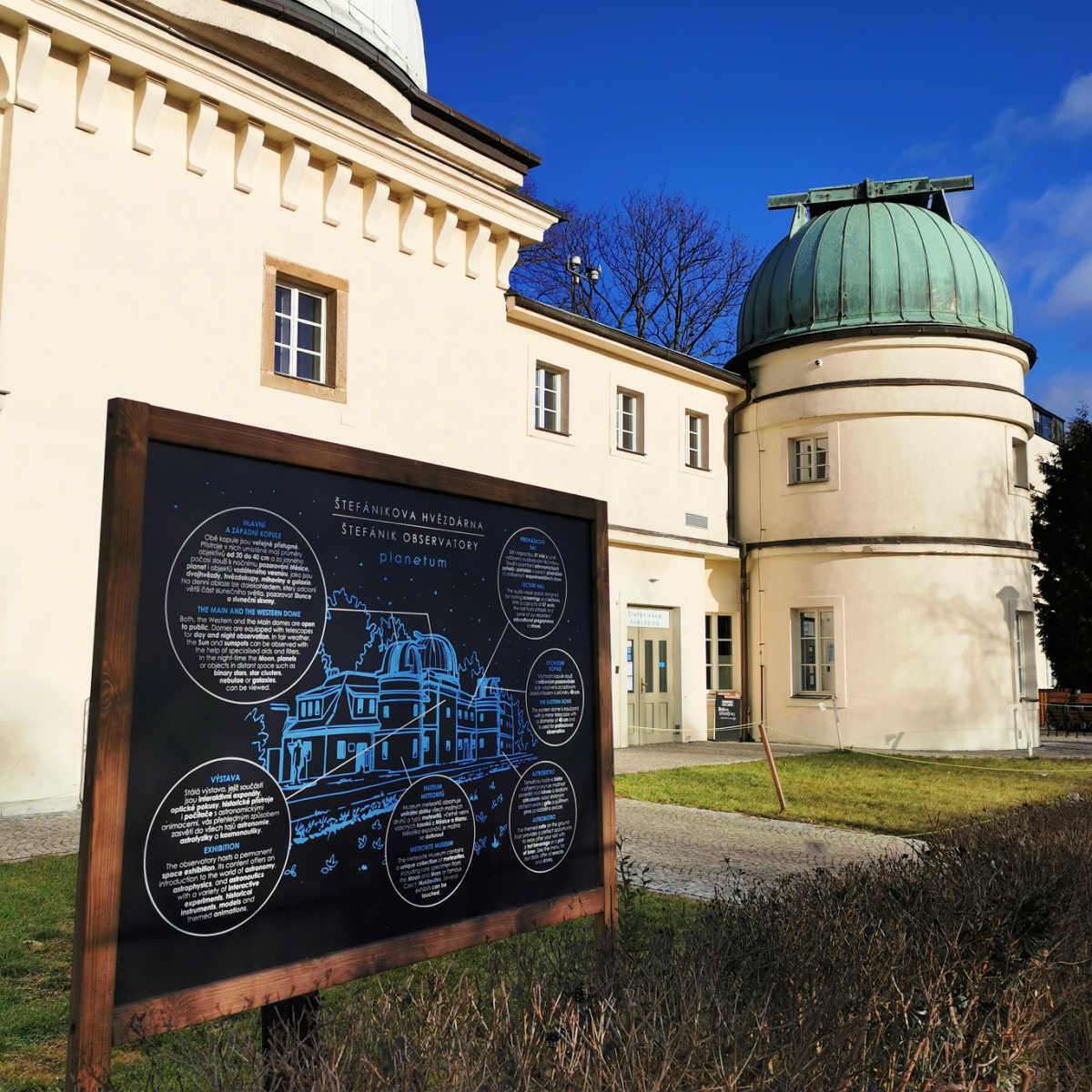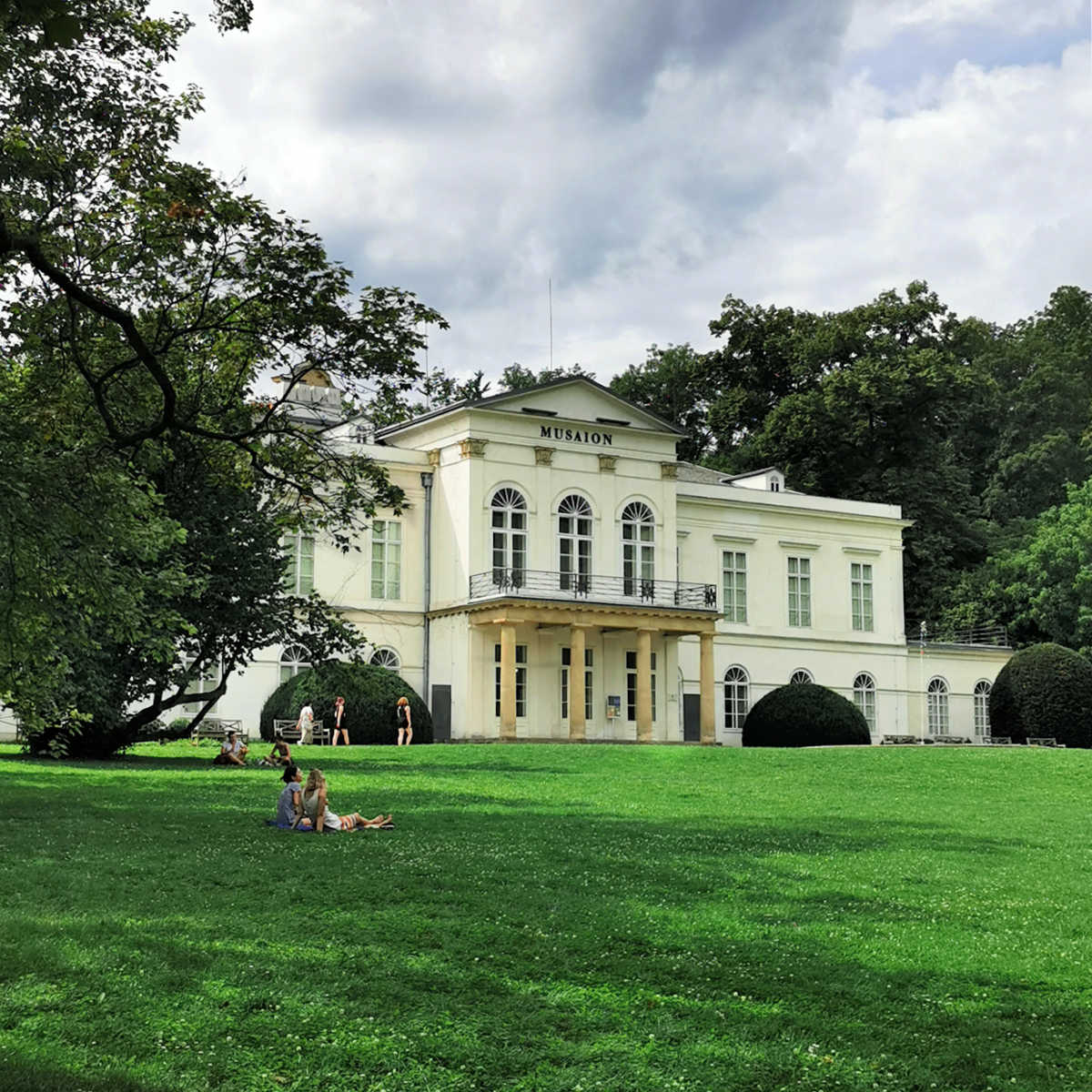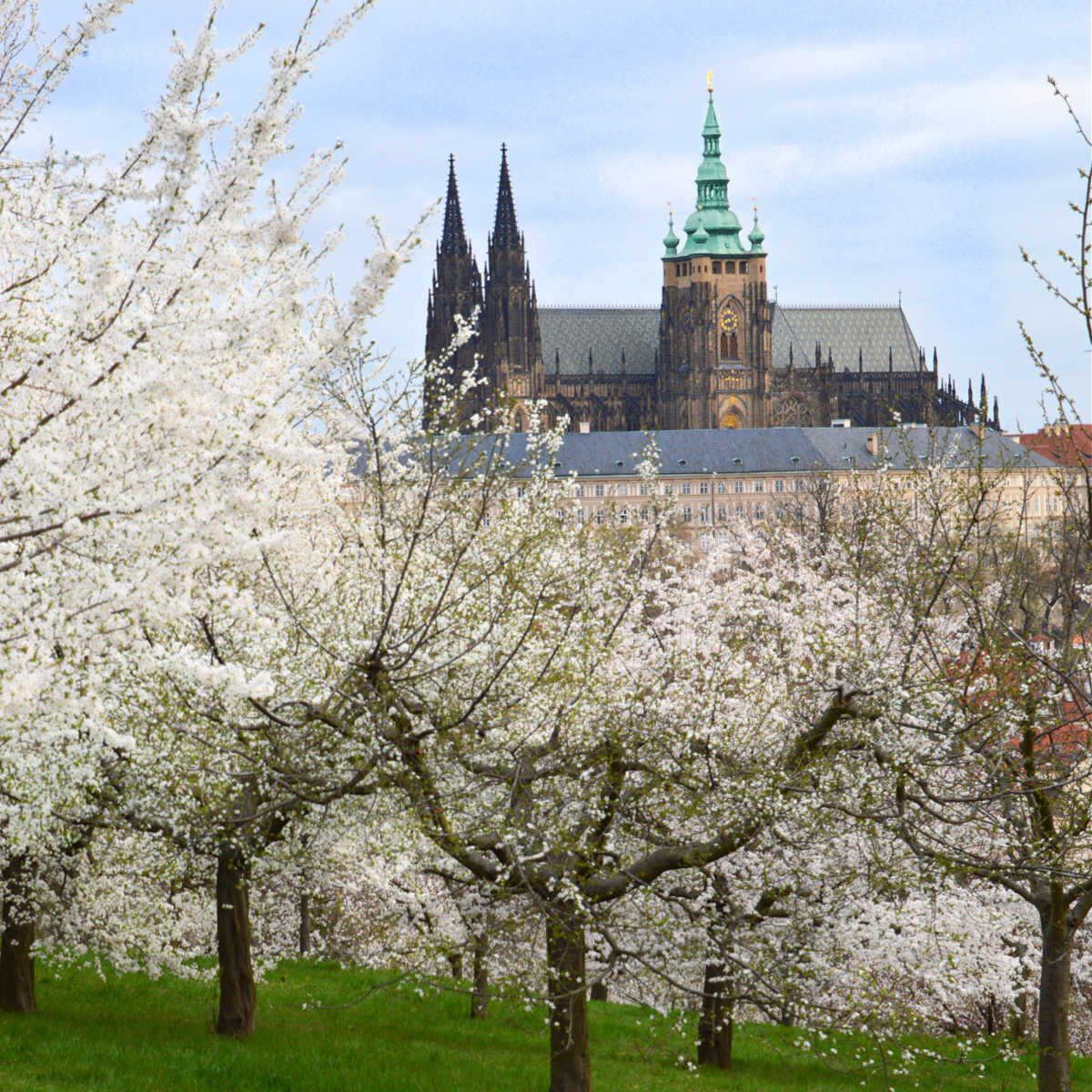A Local’s Guide to Petřín Hill: Attractions, Best Views & Hidden Gems
You can’t miss Petrin as it’s a 327-meter-high hill in the centre of Prague on the right bank of the Vltava River. Petrin is one of my favourite places to visit in Prague, not only because it’s the closest park area to where I live, but also because I have fond memories of the Kinsky Garden on the side of Petrin Hill from when I was a child.
My language school was just opposite the American Embassy and sometimes we have our lessons in Petrin Park. I was also there when the Pink Floyds and Rolling Stones had concerts at Strahov Stadium and more recently was helping out with guided tours of the stadium itself. So many memories!
But, today, I thought I’d put together a practical visiting guide to Petrin Hill so that you can start making your own memories when you visit this part of Prague. I’ve added my favourite places to visit and see, my local tips for cafes and hidden gems to see.

Quick introduction to Petrin Hill
The most iconic feature of Petřín Hill is undoubtedly the Petřín Lookout Tower, which has a great view of Prague, Strahov Monastery and the Prague Castle.
In medieval times the hill was outside the centre of the town, so I wasn’t surprised when I found out that near the Church of St. Lawrence on the top, there used to be an execution site. After the construction of the Hunger Wall, it was moved to the opposite Vítkov Hill in today’s Prague 3 – Zizkov Area.
Petřín Hill is also quite mysterious as there are 18 underground tunnels, one of which, Tunnel XXII, is even accessible. You can also view an exhibition of photographs called Underground Prague inside it. It is located in the Lobkowicz Garden, right by the so-called scenic path that leads from the Nebozízek funicular station towards Úvoz.
Petřín is mainly made up of sandstone rocks, which is why marlstone has been quarried here since ancient times. You can still see rock formations as you walk around the park.

The Petrin Lookout Tower
The Petřín Lookout Tower is around 378 meters above sea level and it’s what you can see peeking out from the trees on Petrin Hill from pretty much anywhere in the centre of Prague. If you think it reminds you of the Eiffel Tower, you are not wrong!
I’ve climbed the Petrin Tower several times and it’s always been a great experience and the view is definitely worth it.
The builders of the tower from the Czech Tourist Club were inspired by the World Exhibition in Paris in 1889 and decided to build a smaller version in Prague. The design was created by architect Vratislav Pasovský, and the steel structure of the tower was designed by engineers František Prášil and Julius Souček.
The construction work at the top of Petřín Hill began on March 16, 1891. The structure of the tower, stairs, and elevator were assembled in just three months and were opened to the public on August 2, 1891.
READ MORE

Mirror Maze
The mirror maze on Petřín Hill was originally built as a pavilion for the Czech Tourist Club at the Prague Jubilee Exhibition in 1891. The building was designed as a much smaller version of the gothic Vyšehrad Fortifications Gate called Špička, built in the second half of the 14th century by Charles IV.
The maze was built by Matěj Bílek and designed by Antonín Wiehl and it originally stood near the corner of the Industrial Palace next to Stromovka Park. The building was moved to Petřín next to the Petřín Lookout Tower two years later.
In the central hall, there is a diorama showing the battle between the people of Prague and the Swedes on Charles Bridge in 1648.
The maze is quite small but fairly entertaining for children, There are 35 regular mirrors that create the maze and 15 distorting mirrors, which make you tall, thin or big as you walk by.

The Stefanik Observatory
The Štefánik Observatory has extended opening hours to allow people to watch the day and night sky throughout the year. There are also regular talks, events and the observatory has a museum with various exhibitions, such as the astronomy or meteorite exhibition.
The observatory is equipped with several telescopes for both day and night observations. The most popular is the largest telescope with three refractors under the main dome. It is used for exploring the night sky but also allows for observations of the solar surface.
This 5.5-ton Zeiss Astrograph Telescope was made in 1905 and purchased in 1928 from the estate of Viennese selenographer König. The telescope has been affectionately nicknamed ‘Konig’ by the observatory staff.

The Kinsky Summer House – Folk Museum & Garden
This garden originally belonged to the Kinsky family, who were a local well-to-do family and chose the Smichov side of Petrin Hill to build their summer palace and turn the surrounding area into a beautiful park and gardens.
The Kinsky Summer Palace is now being used as an Ethnographic museum that displays Czech and regional folk costumes, traditions and crafts. It was closed to the public for a long time and used as an archive, so it’s lovely to visit the inside of the house too.
There is a coffee place on the side of the building, which you can use without paying the entrance fee (which by the way is very affordable fee for a museum in Prague). The museum often puts on different events, such as traditional cake baking, dancing, special exhibitions, concerts or talks.
READ MORE

Petrin Hill Gardens
Petrin Park is formed by several gardens, which over a period of time were linked together. You can walk through the Kinsky Garden, Lobkowicz, Nebozízek, Rose Park, Seminary Garden and Strahov Garden.

Flower Garden – Kvetnice
At the top of Prague’s Petřín Hill is one of Prague’s most charming gardens called Květnice – The Flower Garden. This sunken perennial garden was created under the boundary wall of the Petřín Park Rose Garden between 1935 and 1937. It was built on a landfill, on the site of former military grounds. The only entrance to the garden is through a metal gate that you will find near the Štefánik Observatory.
This garden is a complete hidden gem, it looks like it’s set in a small valley defined by walls and tall trees on the slope above Nebozízek. It’s mainly planted with perennials, but in spring it’s full of tulips. I always think, that Květnice looks more like a typical English garden, enclosed and hidden from public view.

The Rose Garden
The Rose Garden at the top of Petřín Hill is one of the biggest rose gardens in the Czech Republic – the biggest one is at Olomouc and at botanical garden in Pruhonice Chatteu just outside Prague.
Originally this area was used by a nearby army, but it was gradually transformed into a garden after 1932.
There are over 8000 roses planted on area of approximately 6 hectares, including pretty climbing roses. The rose scent is amazing, especially in early summer, but some roses flower as late as mid October.

The Seminar Garden
The part of Petrin Hill that’s closer to the Lesser Town is what used to be a secluded Seminar Garden belonging to the Carmelites monastery of the Virgin Mary of Victorious in the 17th century. In 1784 the monastery was abolished and over the next centuries, fruit and almond trees as well as more shrubs were planted there.
Prague Town bought the garden in 1927 and removed the garden walls to integrate it into the rest of Petrin Park and opened it to the public in 1930. As you walk up the hill through the Seminar Garden, you can still see the Church of Our Lady Victorious and a few buildings behind, which is what remains from the monastery.
The entrance to the church is from Helichova Street and you can see the well known The Infant Jesus of Prague there when you visit.
The famous Czech writer Jan Neruda was born in Ujezd Army Barracks (now long gone) and you can see his bronze statue from 1970 created by Jan Simota, in the lower part of the garden.
Another reminder that this used to be a monastery garden is the little chapel in the middle of the garden. It’s not exactly known when it was built, but the maps definitely show the chapel in 1769. After the closure of the monastery, the chapel was used as the first observatory on Petrin Hill until 1903.

Vrtba Garden
On the slope of Petřín Hill, you can also visit one of the most beautiful Baroque gardens in Prague, the Vrtbovská Garden. The garden’s entrance is from Karmelitská Street in the Lesser Town, but you can see the walls going halfway up to Petrin Hill. ]
There is a small charge to enter the garden, but I think it’s well worth it. The garden has many different terraced gardens with shrubs, flower beds, apple trees and also amazing statues. There is an amazing view of the garden and the Lesser Town from the top of the garden – I can never get tired of seeing Prague from there!
READ MORE

Strahov Monastery
On the side of the Petřín Hill towards the Prague Castle, you can also find the Strahov Monastery with a beautiful Baroque library, a historic picture gallery and a St. Norbert microbrewery. Just under the Strahov Monastery, you have more amazing views of Prague, probably the best ones in the whole of Prague.
READ MORE

Hunger Wall
As you walk up from Kinsky Garden and when you get to the top of the Petrin Hill, you will notice a tall wall.
This is the historical Hunger Wall, built by one of the most important kings of Bohemia Charles IV between 1360-1362. It’s named ‘Hunger’ because it provided employment for the poor people of Prague who would otherwise go hungry.
The wall was part of the medieval fortifications of the city. Part of the Baroque fortifications of Prague has also been preserved on Petřín Hill – bastions No. IV (St. Charles), No. V (St. Lawrence), and No. VI (St. Adalbert).

Pink Tractor
If you like modern and unusual art, follow the street on the side of the Strahov Stadium until you see a pink tractor with a large hanging key padlock. This is one of the most recent art statues by David Cerny and it’s here because it marks the spot where the Czech band ‘Vysaci Zamek’ – Hanging Padlock or a Locker’ used to play in a local pub.
The sculpture is made with Zetor 40 type, because it’s dedicated to the 40th years anniversary of the band’s first performance. This new sculpture was installed in 2022.
Location – Vanickova Street, Prague 6 – next to the Strahov Stadium behind Petrin Hill.

Strahov Stadium
Strahov Stadium is the largest stadium in the world and partly because of that, it’s been difficult to find a continuous use that would prevent the building from declining.
Back in 1913 the Czech Sokol Organization (sports organisation) had an idea for a large sports park in the area of the former Strahov quarries, which was to include children’s playgrounds, sports fields as well as a Sokol stadium. The first Strahov Stadium was built in 1926 by Alois Dryák as a wooden structure and was used for about six years.
The stadium, that you can see today, was built in various stages in 1948 and and then in 1975. During this time, the stadium was uses as the venue for Spartakiads – mass gymnastics performances held once every five years.
After the fall of the communist regime, the stadium began to deteriorate as it was no longer used, although it was used occasionally for large concerts, such as Pink Floyd, AC/DC or Rolling Stones.
From the early 2000s the Prague football club AC Sparta use it as a training ground after they invested in building facilities for their players and created seven standard-sized football pitches for training. Last time I heard, they are also planning to move their base there from Letna.
Petrin Hill Statues &Art
At the end of the park, you will see the statues of the Memorial to the Victims of Communism as they walk down the steps towards the Ujezd.
Halfway down Petrin Hill, you can also see the famous statue of the poet K. H. Mácha by J. V. Myslbek, created between 1910-1912.
Other famous personalities also have their statues on Petrin Hill, for example Jan Neruda, Jaroslav Vrchlický, Vítězslav Novák, and Hana Kvapilová.

Where to eat & drink at Petrin Hill
This one is a bit tricky! In all honesty, you are on the top of a hill and in a park, so please don’t expect a Michelin-star restaurant! There are a few restaurants and bistros scattered around, but I always find the offerings middling and the prices similar to the middle of Prague. The reviews are also fairly low for most of these places, but they are absolutely fine for a drink or a coffee.
My favourite place for coffee is not on the top of the Petrin Hill, but in the Ethnographic Museum in Kinsky Garden . It’s a very non-touristy cafe called Dorado Coffee Kinsky, which has good coffee, local cakes, normal prices and also great reviews. The locals stop here after walking their dogs, ladies enjoy getting together for an ice-cream and I usually have a coffee before I start the hike up the Petrin Hill.
If you fancy stopping for a quick lunch or light meal, I’d recommend the student’s canteen called Menza Strahov on the way to Petrin Hill from Strahov Stadium bus stop. It’s one of my favourite traditional Czech self-service canteens in Prague, which has a large capacity, long opening hours, great prices and a picture menu with English descriptions. The canteen is open to the general public, so you don’t need to feel like you are intruding.
Once you walk to the top of Petrin Hill, you have a choice of fairly pricey A La Petite Eiffel with a great views of the Petrin Tower itself, or the Astrobistro – Planetum, laid back bistro at the Planetarium or newly open I love you Bistro, which is more of a coffee place. In the summer I’ve also seen a coffee cart right in front of the Petrin Tower, which is great for takeaway coffee. There is a little cafe at the tower itself (Petrin Tower Cafe), but again it’s fairly pricey and always quite busy to get in.
If you want to have some good views with your afternoon coffee, then you have a choice of Petrinske Terasy or Nebozizek. Both are half way up the Petrin Hill and also do food. The Strahov Monastery V Raji beer garden is also great in the summer and the food is good in the restaurant ‘Na Pekle‘.
I should also mention a complete hidden gem, which is Garden Cafe Taussig, which is just on the way to Petrin Hill at Vlasska Street 25. Prices are slightly higher than in local cafes, but you get some lovely views of Prague Castle from a cafe terrace. The best thing about this place, is that it is a training cafe that employs people with mild learning disabilities and mental health issues and helps them to improve their work and social skills. Now you know, your coffee will taste even better, right?
If you are a tram fan, like me, you’ll absolutely love my next hidden gem, which is Tocna Dlabacov bistro. It’s based at Dlabacov tram loop (as you walk down from Strahov Stadium or just outside the Strahov Monastery) and goes great burgers, fries with cheese and bacon and of course beer, cocktails and homemade lemonades. And the best bit is that you can enjoy your food sitting in an old restored red tram or on the steps right next to the tram. And don’t worry the trams don’t actually run through the loop anymore.

How to get to Petrin Hill
The most popular way to get to the top of Petřín Hill is by an funicular cable car. It is the oldest ground funicular in the country and measures 510 meters. But, it’s currently being modernised and closed until 2025-2026. Fortunatelly, there are other ways to get to the top of Petrin Hill, most of which are fairly easy, although some involve a bit of walking.
Once you are on the top of of Petrin Hill, you can also walk towards the Strahov Monastery (about 10 minutes walk) following the Hunger Wall and further to the Prague Castle (20-25 minutes).
You can also walk along the Hunger Wall to the Kinsky Garden for a longer walk (20-30 minutes depending on how far you want to walk and then to Kinsky Square to get no.9, 12 or 15 tram back to the centre of Prague (or Smichov).
I also often walk down the Petrin Hill following the Vlasska Street to see The Hospital Church of the Merciful Sisters of Saint Karla Boromejský in Prague, the Lobkowicz Chateau and Garden (now German Embassy) and more quirky streets under the Prague Castle.
The street will eventually take you to the side street next to Vrtba Garden and Lesser Town Square (where you can continue your walk to the centre via Charles Bridge or see the Kampa Island with Lennon Wall first).
This blog post was originally written on 25 October 2024 and last updated on 25 October 2024
PIN TO KEEP FOR LATER







